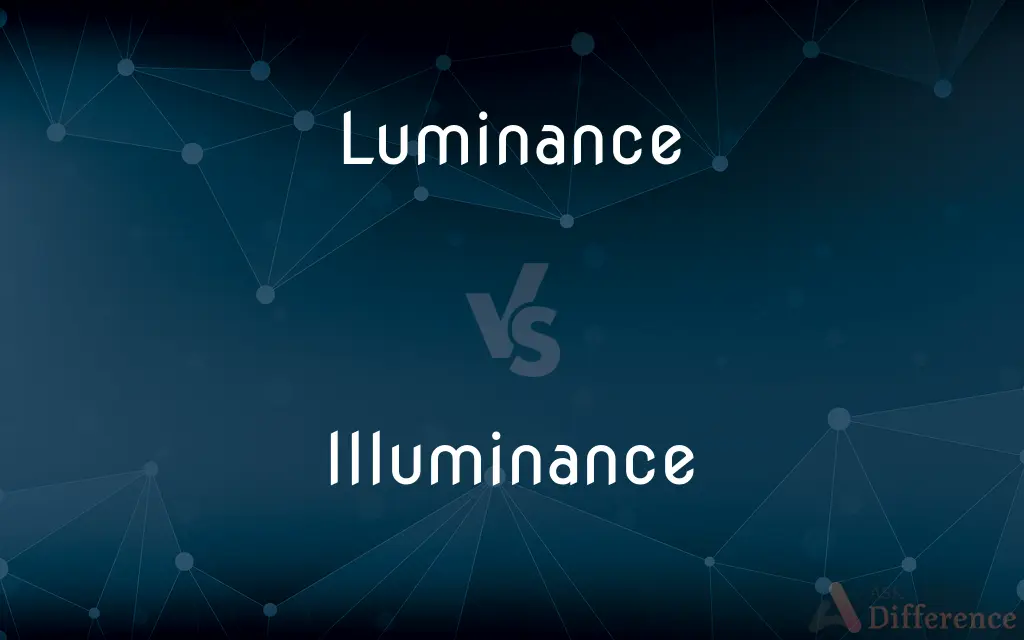Luminance vs. Illuminance — What's the Difference?
Edited by Tayyaba Rehman — By Maham Liaqat — Updated on April 15, 2024
Luminance measures the brightness of light emitted or reflected from a surface, whereas illuminance quantifies the amount of light falling onto a surface.

Difference Between Luminance and Illuminance
Table of Contents
ADVERTISEMENT
Key Differences
Luminance is a measure of the intensity of light perceived by the human eye coming from a particular surface in a specific direction. It is expressed in candelas per square meter (cd/m²) and is concerned with how bright a light source or surface appears to the observer. On the other hand, illuminance is about the total amount of visible light that hits a surface area from all directions, measured in lux (lx), indicating the amount of light received per unit area.
Luminance reflects how much light is visible coming off a surface, making it crucial in fields like photography, cinematography, and display technology, where the brightness of screens and images are of interest. Conversely, illuminance is vital in architecture, interior design, and lighting design, as it helps determine how much light a space requires for functionality and aesthetic purposes.
The concept of luminance considers the directionality of light and its interaction with surfaces, focusing on the emitted or reflected light. This directional characteristic influences how we perceive the brightness of illuminated objects. Illuminance, however, deals with the light incident on surfaces without regard to directionality, emphasizing the distribution and adequacy of lighting across different areas.
Luminance can be thought of as a "subjective" measurement since it involves how light is perceived by the human eye from a specific viewpoint. It is crucial for understanding visibility, contrast, and the detail of objects in visual applications. In contrast, illuminance is an "objective" measurement used to ensure that environments are adequately lit according to standard guidelines, impacting activities, safety, and mood in spaces.
The equipment used to measure luminance and illuminance also differs. Luminance meters, or photometers, measure the light emitted from a surface, whereas illuminance meters (lux meters) are used to evaluate the amount of light that illuminates a surface, important for assessing workplace lighting, public spaces, and residential areas.
ADVERTISEMENT
Comparison Chart
Measurement
Brightness of light emitted/reflected from a surface
Amount of light falling onto a surface
Units
Candelas per square meter (cd/m²)
Lux (lx)
Relevance
Perceived brightness, used in visual technologies
Light distribution, used in design and safety
Directionality
Direction-sensitive
Direction-insensitive
Application
Display technology, photography
Lighting design, architecture
Measurement Tool
Luminance meter (photometer)
Illuminance meter (lux meter)
Compare with Definitions
Luminance
The quantity defining the amount of light that passes through or is emitted from a particular area, and falls within a given solid angle.
The new LED screen has a much higher luminance than older models.
Illuminance
The total luminous flux incident on a surface per unit area.
The illuminance in the office was measured to ensure it met workplace standards.
Luminance
Pertains to visual perception influenced by the surface characteristics and ambient light.
The artist chose materials with different luminance qualities to create a desired visual effect.
Illuminance
A measure indicating how much luminous power is seen by the human eye on a surface.
To reduce glare, the illuminance levels were adjusted in the workspace.
Luminance
In technical terms, it refers to the intensity per unit area toward a given direction.
Engineers adjusted the luminance settings to optimize the display for outdoor viewing.
Illuminance
Reflects the effectiveness of lighting systems in covering areas uniformly.
Illuminance mapping helped identify dark spots in the parking lot.
Luminance
A measure of the brightness or light intensity as seen by the human eye from a particular surface.
The luminance of the moon was measured to determine its visibility during the eclipse.
Illuminance
Often planned in building design to achieve energy efficiency and aesthetic goals.
The architect designed the windows to maximize natural illuminance.
Luminance
Used in the context of how "bright" an object appears in terms of light it emits or reflects.
High luminance levels on her computer screen caused her eye strain.
Illuminance
Key in determining adequate lighting for tasks, safety, and comfort.
Proper illuminance is crucial for precision work in labs and factories.
Luminance
Luminance is a photometric measure of the luminous intensity per unit area of light travelling in a given direction. It describes the amount of light that passes through, is emitted from, or is reflected from a particular area, and falls within a given solid angle.
Illuminance
In photometry, illuminance is the total luminous flux incident on a surface, per unit area. It is a measure of how much the incident light illuminates the surface, wavelength-weighted by the luminosity function to correlate with human brightness perception.
Luminance
The condition or quality of being luminous.
Illuminance
See illumination.
Luminance
(Physics) The intensity of light per unit area of its source. Also called photometric brightness.
Illuminance
(physics) The luminous flux incident on unit area of a surface; measured in lux or lumens.
Luminance
The quality of being luminous.
Illuminance
The luminous flux incident on a unit area
Luminance
The amount of light that passes through, is emitted, or is reflected from a particular area, and falls within a given solid angle.
Luminance
The luminous flux emitted in a given direction divided by the product of the projected area of the source element perpendicular to the direction and the solid angle containing that direction (i.e. luminous intensity divided by unit area), measured in stilbs or apostilbs.
Luminance
The quality of being luminous; emitting or reflecting light;
Its luminosity is measured relative to that of our sun
Common Curiosities
What is the main difference between luminance and illuminance?
Luminance measures perceived brightness from a surface, while illuminance measures the amount of light falling onto a surface.
What role does illuminance play in energy efficiency?
Proper illuminance design can significantly contribute to energy efficiency by optimizing the amount of artificial lighting needed, reducing power consumption.
How does illuminance impact workplace design?
Illuminance affects workplace design by determining the amount of light necessary to perform tasks efficiently and comfortably.
Can high luminance be harmful?
Yes, excessively high luminance can cause glare and eye strain, especially in environments with bright screens or lighting.
What factors influence luminance in an environment?
Factors that influence luminance include the light's intensity, surface characteristics, and angle of observation.
How do designers use illuminance in their work?
Designers use illuminance to ensure spaces are adequately lit according to activity requirements and aesthetic preferences.
Is it possible to have high illuminance but low luminance?
Yes, this can occur if the light is diffused across a large area, resulting in high light coverage but low perceived brightness from any point.
Why is luminance important in display technology?
Luminance is crucial in display technology to ensure screens are bright enough to be clearly visible under different lighting conditions.
How are luminance and illuminance measured?
Luminance is measured with a luminance meter, and illuminance is measured with a lux meter.
Can illuminance affect mood?
Yes, proper illuminance can positively impact mood by creating a welcoming and comfortable environment.
Why might a workplace increase illuminance in a specific area?
A workplace might increase illuminance to enhance visibility for safety reasons or to improve employee productivity by reducing eye strain.
How do changes in luminance affect visual perception?
Changes in luminance can affect how we perceive color and depth, impacting visual clarity and contrast.
What is the relationship between luminance and contrast?
Luminance levels directly influence contrast, which is essential for distinguishing objects and details in visual tasks.
How do you adjust luminance on electronic devices?
Luminance on electronic devices can be adjusted through brightness settings, often found in the display settings menu.
What standard guidelines exist for illuminance?
Guidelines for illuminance levels are provided by organizations like the Illuminating Engineering Society (IES) for various environments such as offices, schools, and public areas.
Share Your Discovery

Previous Comparison
Embedded vs. Integrated
Next Comparison
Mistake vs. FailureAuthor Spotlight
Written by
Maham LiaqatEdited by
Tayyaba RehmanTayyaba Rehman is a distinguished writer, currently serving as a primary contributor to askdifference.com. As a researcher in semantics and etymology, Tayyaba's passion for the complexity of languages and their distinctions has found a perfect home on the platform. Tayyaba delves into the intricacies of language, distinguishing between commonly confused words and phrases, thereby providing clarity for readers worldwide.














































